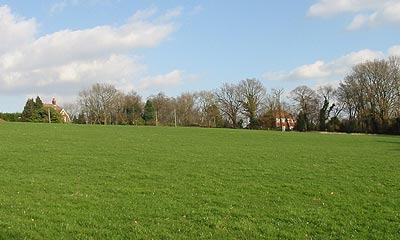Self Build Guide - Self Build House Plot Sizes
How big a plot do I need for a 1,800ft² four bed detached house?
How big is half an acre?
The average estate house these days is built on approximately 1/12th - 1/10th of an acre about 38ft x 95ft (11.5m x 29m).
This size plot may not allow for a very large garden or very good access around the house.
The minimum size for a plot can be easily calculated using the following formula:
Depth of plot = depth of proposed self build house + 65ft (20m)
Width of plot = width of proposed self build house + 10ft (3m)
When you view a plot always make sure you know the exact position of the boundaries. Always double-check the dimensions and when you return home transfer these to graph paper and have a paper cut out of the footprint of your proposed self build house to sit onto the site you have drawn.

Planning
There are basically three types of permission that can apply to any building land, and the local area planning office grants these:
1. No planning permission granted.
2. Outline planning permission granted. (noted as OPP in many adverts)
3. Detailed planning permission granted. (noted as DPP in many adverts)
The particular type of permission granted on a plot is what influences the value of that plot, so you can see why it is advantageous to have a working knowledge of the permissions available.
The planning acts are concerned with whether or not a dwelling can be built at all in a particular locality, with its appearance and the way in which it will relate to its surroundings. This control is exercised by the Local Authority, to which an application has to be submitted to erect any new dwelling.
Members of the public are entitled to appeal to the Minister for the Environment against any decision of the local authority in a planning matter In theory all planning applications are considered by a committee of councilors who are advised by the councils professional planning officers, but in practice they often just rubber stamp the recommendations of the planners for run of the mill applications. The planners make their recommendations in accordance with set criteria after going through set procedures. The way to obtain a planning consent quickly and easily is to ensure that it meets all of the established criteria for an approval. This fact is often forgotten. A planning officer does have the discretion to make recommendations that are at variance with the planning policy, but this is unusual. The golden rule is to avoid applications that are contentious, and to present anything unusual in a non-contentious way.
Detailed Planning
Detailed or full planning permission is the stage at which construction can start (subject of course to building regulation approval).
By now the reserved matters would have been agreed with the local planning authority. These are items for which proposals have been submitted and agreed with the local planning authority prior to the end of the outline planning consent period, such as the entry position onto the site from the highway, visibility splays etc.
Almost all detailed consents are granted subject to a condition that requires the commencement of the building works within a five year period from the date that the detailed consent becomes effective.
Detailed or full planning permission basically means that all aesthetic aspects of the building are agreed with the local authority, such as type of roofing tiles/slates, window styles, brick type/colour etc.
If you purchase a plot with detailed planning permission already granted, you should request that the drawings for the scheme are included within the purchase price, and get written confirmation that you will be allowed to utilise them at no extra charge from the architect that designed the dwelling.
Planning Appeals
Before submitting an appeal, speak to the LPA to try and resolve any problems or disagreements. Agreement may be possible by amending the proposals.
An Appeal is intended to be, and should remain, a last resort.
The right of Appeal - Appeals to the Secretary of State for the Environment (or in Wales the Secretary of State for Wales) are possible in the following circumstances:
a) If an application has been made to the LPA for planning permission, and the LPA has: refused permission outright; given permission but with conditions considered unreasonable; refused approval of the details of a scheme for which they have already granted outline planning permission; approved details of such a scheme but with conditions considered unreasonable;
b) If the LPA have failed to issue a decision on an application for permission or approval within the time limit laid down, or any longer period agreed in writing. In normal circumstances the period allowed is eight weeks.
An appeal must reach the Secretary of State, on the appropriate form, within six months of the date of the notice of the LPA's decision.
Making an appeal - To be valid, an appeal must be made on the official form. Up to date forms may be obtained from:
The Planning Inspectorate
Dept of the Environment
Tollgate House
Houlton Street
Bristol BS2 9DL
Great care should be taken when making a planning application as planning is not an exact science. Local residence will have a big input and you will always come across the people who don't like change (NIMBY not in my back yard) or (NODAM no development after mine) are phrases you'll regularly come across.
Continue Reading: Buying a self build plot
September 2004
